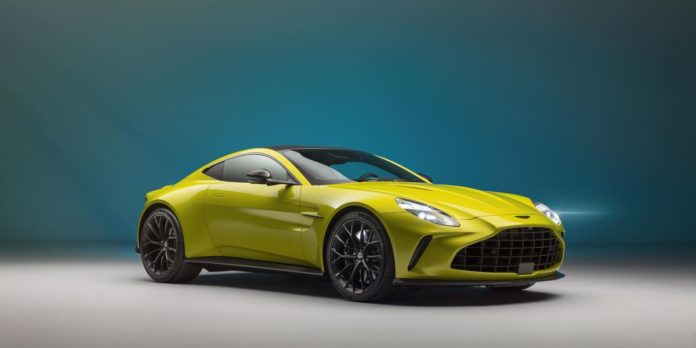- The “regular” Vantage, being facelifted for 2025, will now have 656 horsepower from an AMG V-8—a 128-hp increase.
- Exterior changes are small, but there’s a new interior including a touchscreen.
- Deliveries start in the second quarter of 2024, and the price is expected to be around $190,000.
Midlife facelifts of successful models normally bring small revisions. But not the 2025 Aston Martin Vantage. Bodywork changes are limited—there was little wrong with the looks of the outgoing version—but the Vantage has also been given an all-new interior and a huge power increase. In V-8 guise, the outgoing Vantage boasted a maximum output of 528 horsepower in turned-up F1 Edition guise. This new Vantage boasts an enormous 656 horsepower and output that sees it leapfrogging rivals such as the Porsche 911 Turbo S and the Mercedes-AMG GT63.
Other revisions include a stiffened body structure, smarter active dynamics, and an all-new infotainment system. The revised car still carries the Vantage name, although we know that thought was given to changing it, but Aston insiders say that the overall scale of the changes is even greater than the one that turned the DB11 into the DB12.
The outgoing Vantage was already a handsome beast, so we aren’t surprised that visual changes are limited. The front end gets a new bumper and fenders to wrap around what will be standard LED headlights and also a substantially larger radiator grille. The increase in area is driven by both form and function, with the amount of air reaching the revised car’s radiators increased by a full 50 percent. That means if the new Vantage continues its predecessor’s Formula 1 safety car duties—which seems likely, given Aston’s close connection to the sport—it will apparently be able to do so without any extra cooling.
The new Vantage’s arches are filled by what will be standard 22-inch forged alloy wheels with fatter tires, necessitating a one-inch increase in body width. From the side it is distinguished by DB12-style vents behind the wheel arches carrying Aston branding, and the flush-fitted door handles will now automatically deploy when the car is stationary and they detect the proximity of the key. As before, the lower sill cover is a structural rather than cosmetic component, and it will now be possible to specify it in carbon fiber. The rear profile is little changed beyond small vents set into the bumper and larger=diameter quad exhaust tailpipes.
Much bigger changes have been made where they were really needed: inside the Vantage’s cabin. The new car has been given a set of updates very similar to those of the DB12, with a redesigned center console that rises at a shallow angle to a new touch-sensitive infotainment screen; physical switchgear is identical in both cars. The old Vantage’s three-part digital dashboard, with a central rev counter, has also been replaced by a single instrument display.
As on the DB12, a mild disappointment is the loss of the PRND transmission control buttons that have been a characteristic feature for a generation of Astons. They have been replaced by a small, stubby gear selector for the standard automatic gearbox. Other than that, having seen the new car up close, our overall impression was of a dramatic upgrade in both design and ergonomics.
The new Vantage’s engine shares its layout, capacity, and AMG bloodline with its predecessor: a 4.0-liter twin-turbo V-8. But as with the DB12, it has been given numerous internal upgrades to boost performance, with new turbos and a heavily revised top end, as well as much better cooling. Peak torque has risen to 590 pound-feet, an 85-pound-foot increase over the Vantage F1 Edition, available all the way from 2750 to 6000 rpm. The final-drive ratio for the standard ZF-supplied eight-speed auto has also been lowered, improving acceleration further. (Sadly, there will never be a manual option.) Aston claims the new car gets to 60 mph in 3.4 seconds, but we would be surprised if we didn’t beat that given the F1 Edition blasted its way through the benchmark in 3.5 seconds with 158 less horsepower. Top speed is claimed to be 202 mph.
Beneath the surface, the Vantage’s body structure has been stiffened with new reinforcement pieces; the improvement across the whole car is quoted as 7 percent, but in key areas close to suspension attachment points, it is much more than that. Adaptive dampers will be standard, offering a much greater range of force adjustability than in the old car. Buyers will also be able to choose between cast iron and carbon-ceramic brakes.
The old Vantage had separate control switches for its adjustable powertrain and chassis settings, but the new one has a single controller for all functions. There will be five dynamic modes—Wet, Sport, Sport Plus, Track, and Individual—which modify engine, damper, and power steering settings as well as the reactions of the electrically controlled torque-biasing rear differential. A new six-axis accelerometer and faster-acting software allow for quicker and more progressive stability control intervention, something that Aston’s director of vehicle performance, Simon Newton, tells C/D is critical to maintaining drivability given the amount of power being delivered through a single axle. It will also feature an adjustable traction control system to help maintain control when the rear tires are pushed beyond their limits.
The increase in performance is set to be matched by an increase in price. We don’t have a confirmed number yet, but expect the new Vantage to be around $190,000—nearly $20,000 more than the previous Vantage F1 Edition—with the first customer deliveries starting in the second quarter of the year.
Our man on the other side of the pond, Mike Duff lives in Britain but reports from across Europe, sometimes beyond. He has previously held staff roles on U.K. titles including CAR, Autocar, and evo, but his own automotive tastes tend toward the Germanic: he owns both a troublesome 987-generation Porsche Cayman S and a Mercedes 190E 2.5-16.

